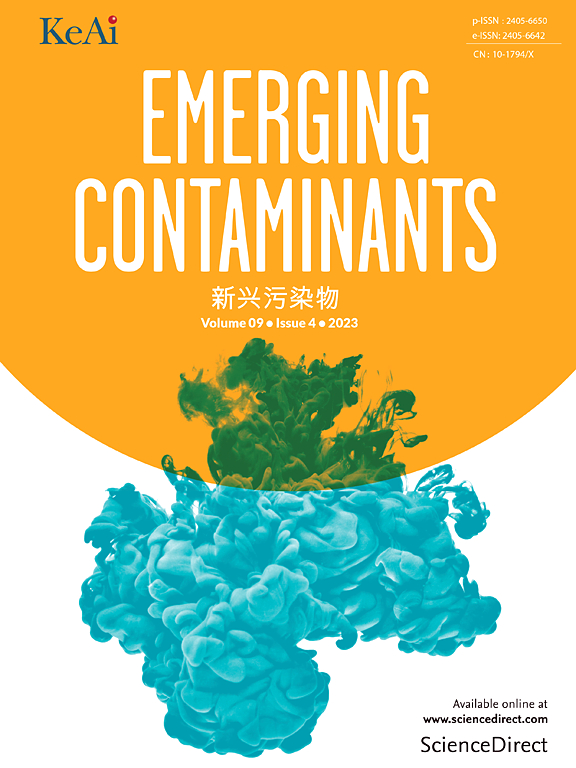人尿中二硫代氨基甲酸酯硫化促进剂的发生及其暴露量估计
IF 6.9
2区 环境科学与生态学
Q1 ENVIRONMENTAL SCIENCES
引用次数: 0
摘要
二硫代氨基甲酸酯硫化促进剂(DVAs)广泛用于橡胶制造,但其潜在的人类接触和相关的健康风险仍然知之甚少。以前的研究已经在各种环境基质中发现了DVAs,如粉尘和沉积物,但它们在人类生物样本中的存在情况尚未得到调查。本研究旨在填补这一关键的研究空白,通过对人类尿液中的DVAs进行首次全面的生物监测评估,提供人类暴露的直接证据。共收集了263份中国成年人的尿液样本,并分析了8种DVAs。8种目标化合物中有7种被检测到,检测频率从14%到94%不等。二乙基二硫代氨基甲酸锌(ZDEC)为主要化合物,平均浓度为1.6 ng/mL(范围:LOD-12 ng/mL)。值得注意的是,男性尿中ZDEC水平显著高于男性(1.7±0.28 ng/mL vs. 1.3±0.33 ng/mL);p = 0.021)和二丁基二硫代氨基甲酸锌(ZDBC;0.78±0.18 ng/mL vs. 0.50±0.10 ng/mL;p = 0.017),而尿中ZDEC和二苄基二硫代氨基甲酸锌(ZBEC)浓度与年龄呈负相关。日暴露(DE)估计显示,ZDEC的平均DE值最高,为48 ng/kg bw/day,其次是ZEPC (29 ng/kg bw/day)和ZDBC (21 ng/kg bw/day)。这些发现对人类接触DVAs的模式提供了重要的见解,为未来的风险评估和监管考虑提供了科学依据。鉴于这些化合物的广泛检测及其潜在毒性,有必要进一步研究以阐明其健康影响和主要接触途径。本文章由计算机程序翻译,如有差异,请以英文原文为准。

Human urinary occurrence of dithiocarbamate vulcanization accelerators and their exposure estimation
Dithiocarbamate vulcanization accelerators (DVAs) are widely used in rubber manufacturing, yet their potential human exposure and associated health risks remain poorly understood. Previous studies have identified DVAs in various environmental matrices, such as dust and sediments, but their occurrence in human biological samples has not been investigated. This study aims to fill this critical research gap by conducting the first comprehensive biomonitoring assessment of DVAs in human urine, providing direct evidence of human exposure. A total of 263 urine samples were collected from Chinese adults and analyzed for eight DVAs. Seven out of eight target compounds were detected, with detection frequencies ranging from 14 % to 94 %. Zinc diethyldithiocarbamate (ZDEC) was the predominant compound, with a mean concentration of 1.6 ng/mL (range: <LOD–12 ng/mL). Notably, males exhibited significantly higher urinary levels of ZDEC (1.7 ± 0.28 ng/mL vs. 1.3 ± 0.33 ng/mL; p = 0.021) and zinc dibutyldithiocarbamate (ZDBC; 0.78 ± 0.18 ng/mL vs. 0.50 ± 0.10 ng/mL; p = 0.017) compared to females, while urinary concentrations of ZDEC and zinc dibenzyldithiocarbamate (ZBEC) were inversely correlated with age. Daily exposure (DE) estimation revealed that ZDEC had the highest mean DE value at 48 ng/kg bw/day, followed by ZEPC (29 ng/kg bw/day) and ZDBC (21 ng/kg bw/day). These findings provide essential insights into human exposure patterns to DVAs, offering a scientific basis for future risk assessment and regulatory considerations. Given the widespread detection of these compounds and their potential toxicity, further research is warranted to elucidate their health implications and major exposure pathways.
求助全文
通过发布文献求助,成功后即可免费获取论文全文。
去求助
来源期刊

Emerging Contaminants
Medicine-Public Health, Environmental and Occupational Health
CiteScore
10.00
自引率
6.70%
发文量
35
审稿时长
44 days
期刊介绍:
Emerging Contaminants is an outlet for world-leading research addressing problems associated with environmental contamination caused by emerging contaminants and their solutions. Emerging contaminants are defined as chemicals that are not currently (or have been only recently) regulated and about which there exist concerns regarding their impact on human or ecological health. Examples of emerging contaminants include disinfection by-products, pharmaceutical and personal care products, persistent organic chemicals, and mercury etc. as well as their degradation products. We encourage papers addressing science that facilitates greater understanding of the nature, extent, and impacts of the presence of emerging contaminants in the environment; technology that exploits original principles to reduce and control their environmental presence; as well as the development, implementation and efficacy of national and international policies to protect human health and the environment from emerging contaminants.
 求助内容:
求助内容: 应助结果提醒方式:
应助结果提醒方式:


